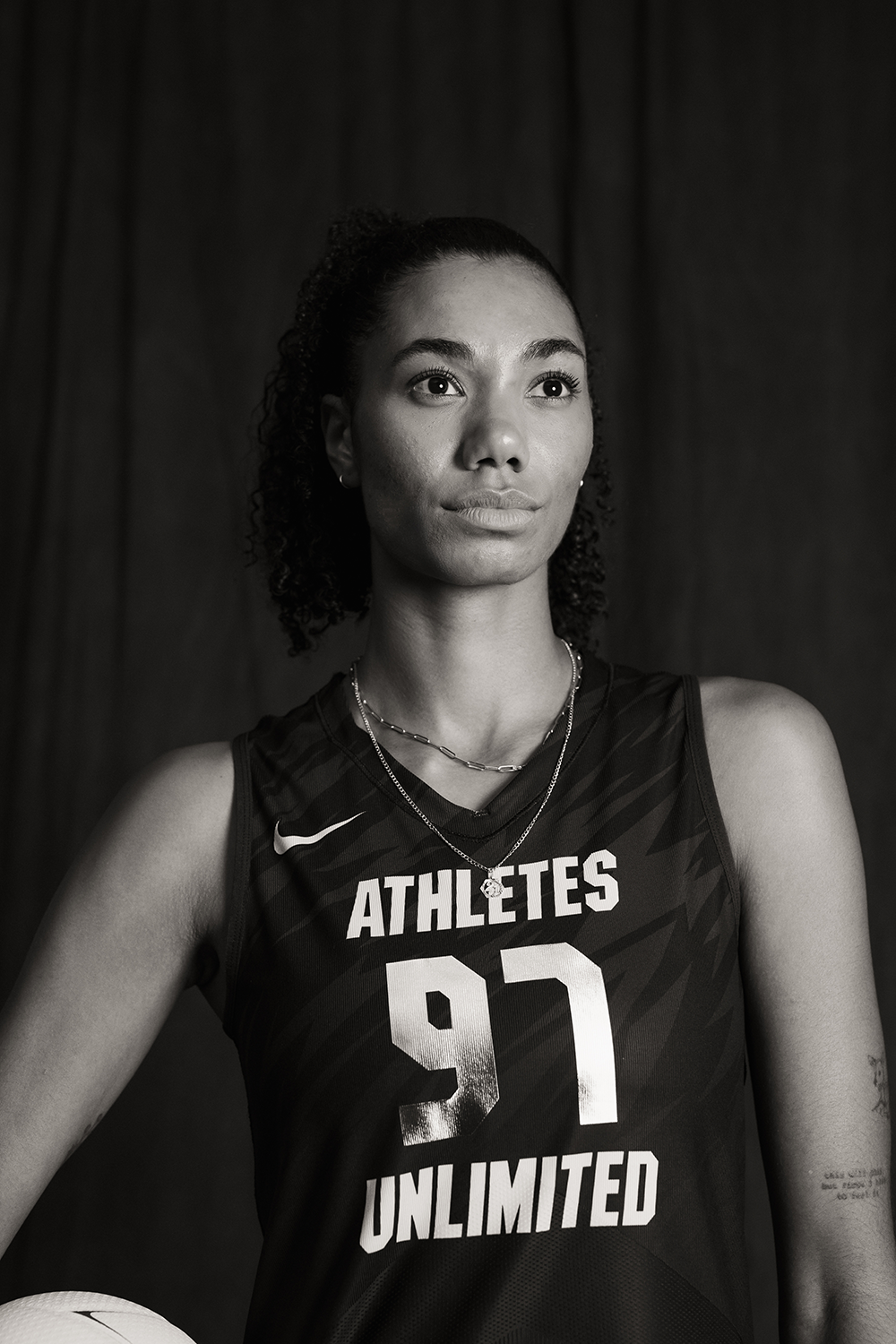Sports
Shoeless Joe Jackson reinstated to MLB, now eligible for Hall of Fame
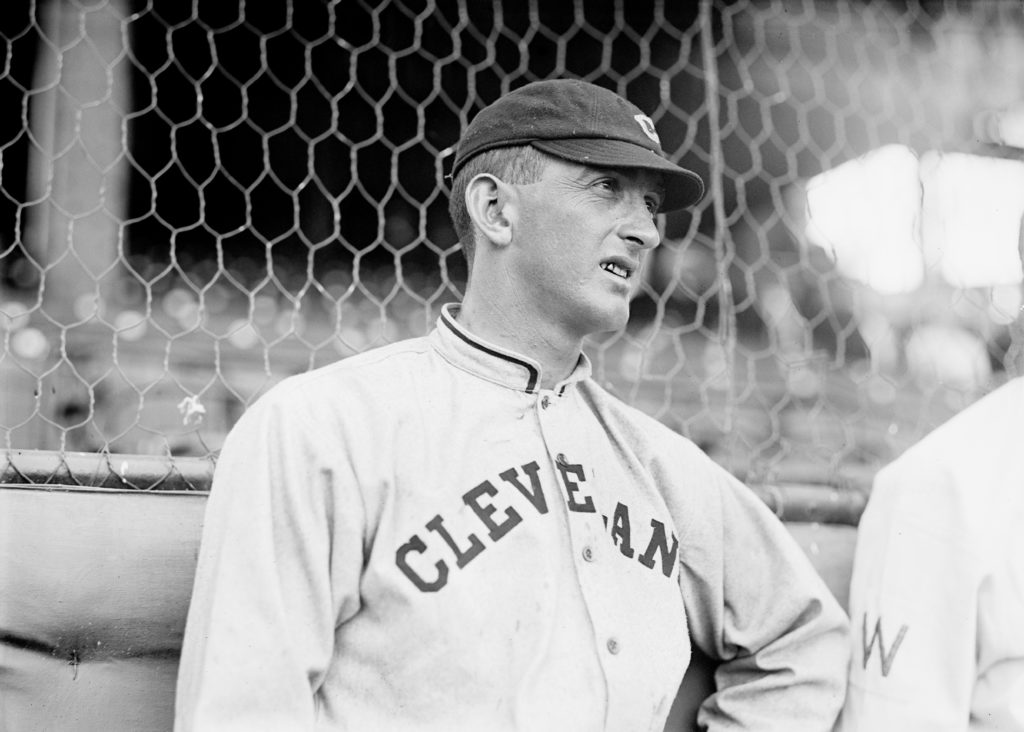

- Former MLB player “Shoeless” Joe Jackson has been removed from the league’s permanently ineligible list.
- This decision by Commissioner Rob Manfred potentially paves the way for Jackson’s Hall of Fame induction.
- The Greenville native played 13 years in the MLB and is remembered locally with a statue and museum.
Greenville native and former pro baseball player “Shoeless” Joe Jackson has returned to good favor with Major League Baseball. He and 16 other deceased players have been officially removed from the league’s permanently ineligible list.
His reinstatement is the first step to Jackson potentially being inducted into the national baseball Hall of Fame.
This decision was made by MLB Commissioner Rob Manfred on May 13, referring to the change as a “policy decision” and marking an end to Jackson’s 104-year ban.
Jackson is joined by 16 other former MLB players who were posthumously reinstated by Manfred’s decision, including legendary names such as Pete Rose, Lefty Williams, and William Cox.

“Obviously, a person no longer with us cannot represent a threat to the integrity of the game,” said a letter from Commissioner Manfred to Pete Rose’s lawyers on May 13. “It’s hard to conceive of penalty that has more deterrent effect than one that lasts a lifetime with no reprieve.”

Who is Shoeless Joe Jackson and why was he banned by the MLB?
The MLB banned Jackson after the 1919 Black Sox scandal, which resulted in him and seven other teammates being found guilty of taking money from gamblers and throwing games during the World Series.
Because of his participation, Jackson was added to the permanently ineligible list in 1921. At the time of his ban, he had hit for more than 50 home runs and finished with a batting average of .356, which was the fourth highest in league history at the time.
The Upstate native played 13 years in the MLB, according to Baseball Reference, a data base with baseball statistics.
Jackson was born in Pickens County but grew up around the Brandon Mill area in West Greenville, where he earned his nickname from batting and running bases in socks, compelling a crowd member to call him a “shoeless son of a gun.”
In Greenville, “Shoeless” Joe Jackson is memorialized with a statue near Fluor Field at the West End and a museum and library.
– A.J. Jackson covers business, the food & dining scene and downtown culture for The Greenville News. Contact him by email at ajackson@gannett.com, and follow him on X (formally Twitter) @ajhappened. This coverage is only possible with support from our readers.Sign up today for a digital subscription.
Sports
Volleyball places four on academic all-district team

Four Hamilton College student-athletes have been recognized on the 2025 Academic All-District® Women’s Volleyball Team, which is selected by the College Sports Communicators (CSC).
Academic All-District Women’s Volleyball Team release
The team honors the nation’s top student-athletes for their combined performances on the court and in the classroom.
Caitlin Allen ’27, Kathryn Fox ’27, Maggie Nichols ’26 and Ayzlinn Trefren ’28 were each named to the CSC Academic All-District® Team for Division III.
The CSC Academic All-America® program separately recognizes women’s volleyball honorees in four divisions — NCAA Division I, NCAA Division II, NCAA Division III and NAIA.
Allen appeared in 18 matches with 16 starts, and was first on the team in total blocks with 15 solo blocks and 56 block assists. She was second in the NESCAC with 1.25 blocks per set. Allen also compiled 86 kills and 14 service aces with a .235 hitting percentage.
Fox played in all 19 matches with 11 starts. The junior was one of four players on the team with over 100 kills, registering a career-best 111 on the year. She was also second on the team in blocks with seven solo blocks and 39 block assists.
Nichols played in all 19 matches with 17 starts during her senior season with the Continentals. She produced 54 kills, and was third on the team in blocks with nine solo blocks and 23 block assists.
Trefren appeared in all 19 matches this season with 18 starts. She totaled a team-high 143 kills and a team-high 195 digs. She also contributed 23 service aces, three solo blocks and 13 block assists.
Sports
Volleyball signs standout Auguste | Wisconsin Badgers
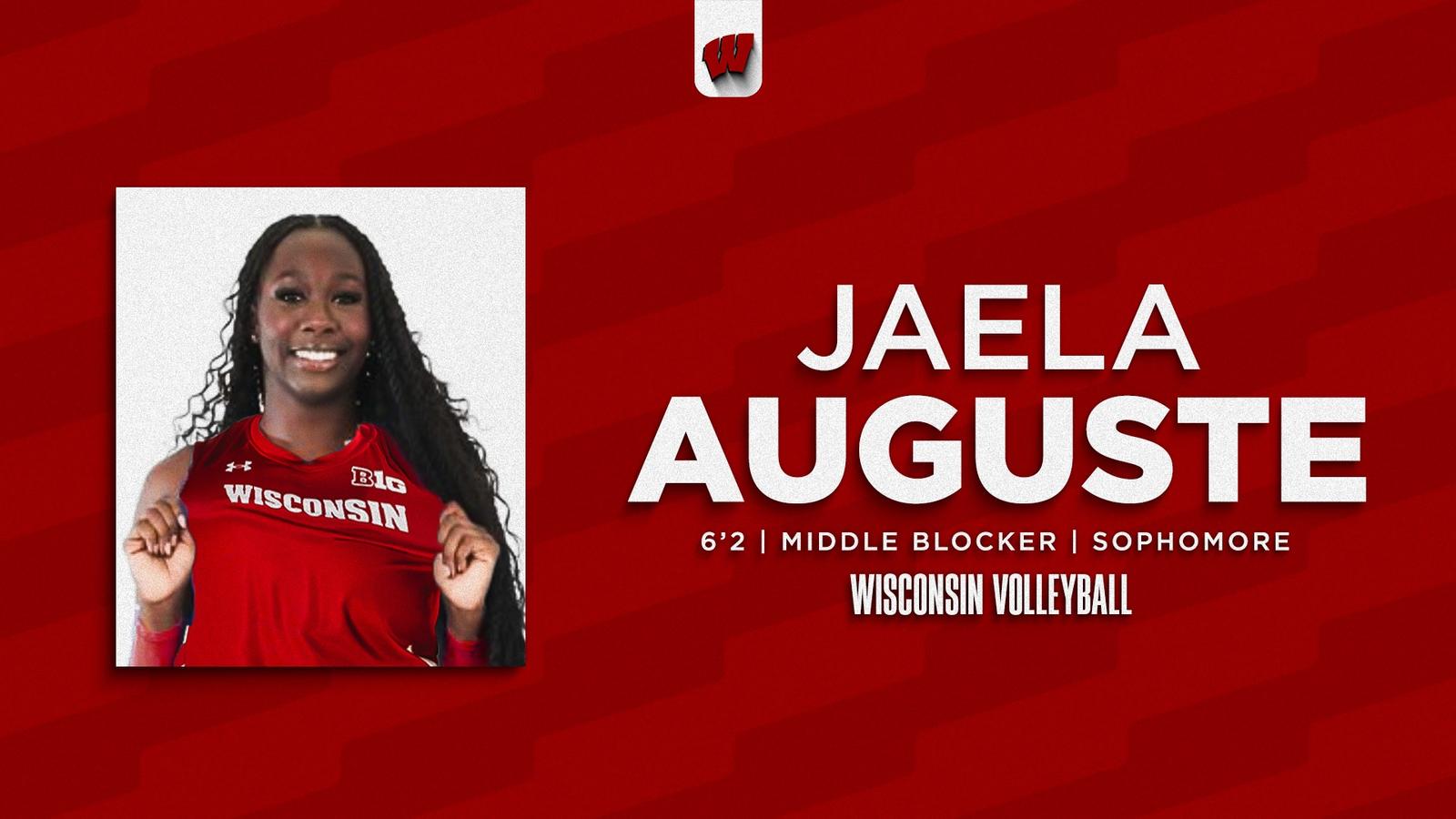
Currently a sophomore, Auguste is fresh off of the best season of her career, earning AVCA Third Team All-American, AVCA Southeast Region First Team and First Team All-SEC honors for the Gators.
“I’m extremely excited to announce that Jaela will be joining our team,” said head coach Kelly Sheffield. “She is one of the most dynamic attackers in the country. Her slide is lethal and she is also great off of two feet. J.J. can also eat up passers from behind the service line. I’m looking forward to having her here this spring.”
The 2024 SEC Freshman of the Year averaged 2.69 kills per set on a .344 hitting percentage from the front court in 28 matches in 2025. Auguste recorded 106.0 blocks on the season, in addition to 27 service aces. The 6-foot-2 middle blocker earned 3.50 points per set as well. In total, Auguste tallied double-digit kills in 17 matches this past year, emerging as a strong producer on the offensive end.
The Spring, Texas, native was a member of the 2025 USA Volleyball U-21 National Team Roster with setter Charlie Fuerbringer.
Sports
William & Mary Hires Head Volleyball Coach

“I’m thrilled that Kellie is joining the Tribe as our head volleyball coach,” said Brian D. Mann, director of athletics. “We very quickly identified her as the person we wanted to lead our program. She had an extraordinary All-American career as a student-athlete at Duke and that, plus her experience as a standout coach at her alma mater and her lifelong passion for volleyball, made her the right choice for William & Mary.”
“William & Mary is an incredible place that offers the best of all worlds, whether it’s athletics, academics or alumni support,” says Catanach Johnson. “I want to build a program that everyone will be proud of while we give our student-athletes a great experience. Everyone I’ve met is so wonderful that I can’t wait to get started!”
Catanach Johnson joined the Blue Devil staff as an assistant in 2019 and was promoted to associate head coach in 2022. She was the recruiting coordinator and responsible for training and program administration. In 2021, she was honored as a member of AVCA’s Thirty Under 30 list.
Prior to Duke, Catanach Johnson was Director of Education Services in the Student-Athlete Academic Services department at Florida State University. She was responsible for day to day operations of educational services and was a liaison to advisors.
During her playing career at Duke, Catanach Johnson was a four-year letterwinner and three-time All-American who starred on a team that made four NCAA appearances and won two ACC Championships. She was the 2010 ACC Player of the Year and she finished her career ranked ninth in assists in the ACC. She had at least 1,000 assists in her four seasons on the team and she was the team captain during her last two years at Duke.
Catanach Johnson’s love of volleyball started early. Her dad, Chris Catanach, coached volleyball at the University of Tampa and in his 42-year illustrious career won four National Championships and was named AVCA National Coach of the Year five times. “My sister and I basically grew up in the gym,” she said. “First we were chasing balls and when I got older I got to do some things with the team.”
Catanach Johnson is taking over a program that finished 12-15 this fall, with a conference record of 7-9. The team just announced the signing of its incoming 2026 freshman class, and current players Kaitlyn Dunnigan, Katherine Arnason and Audrey Brcka were just named to the CSC Academic All-District team.
Catanach Johnson graduated from Duke in 2012 with a Bachelor of Art’s degree and she earned a Master of Science degree in Sport Management from Florida State in 2015. She will be joined in Williamsburg by her husband Dezmond Johnson, eight-month-old daughter Evie and their dog Bentley.
Sports
Pacific Joins ECAC for Outdoor Track & Field

STOCKTON, Calif. – The Pacific men’s and women’s track & field programs will be competing in the East Coast Athletic Conference (ECAC) as outdoor affiliate members, beginning this 2026 season.
The Pacific women previously competed as a Division I independent, while the men begin their first season after the university announced the sport addition in May. The indoor program will participate in the Mountain Pacific Sports Federation (MPSF) once the calendar turns to 2026.
“We are excited for the inaugural season of expanding our program to join the IC4A/ECAC,” Pacific head coach Josh Jones said. “This opportunity allows our athletes to gain valuable championship experience and elevates the standard of excellence within our program.”
The 2026 ECAC Outdoor Track & Field Championships will be held at Rutgers University on April 17-18, 2026, at Bauer Track & Field Complex, co-hosted with the IC4A championships.
Stay Social
For all the latest on Pacific Track & Field, be sure to follow the team on (@PacificXCT), Instagram (@pacific_xc_track) and “like” the team’s official Facebook page (Pacific Cross Country/Track).
#PacificProud
Sports
MIAC Athletes of the Week – December 22, 2025

Ella Peters
Gustavus Adolphus College
Jr. | Guard
River Falls, Wis. / River Falls
Ella Peters made 10 of her 12 shots for a career-high 21 points in the Gusties’ rout of Northwestern-St. Paul on 12/16. Peters scored 19 of her 21 points in the first three quarters of play, and 15 in the first half. Peters has posted double-digit point totals in five of her last six games.
MIAC Women’s Basketball Defensive Player of the Week
Elly Schmitz
Bethel University
Gr. | Forward
Hermantown, Minn. / Hermantown
Elly Schmitz averaged 9.0 rebounds, 2.5 steals, and 1.5 blocks in two victories for the Royals at the Justagame Invitational on 12/19-20. Schmitz came away with nine boards against both UW-La Crosse (12/19) and Coe (12/20), adding four steals and two blocks against the Eagles and one of each in a double-overtime win against the Kohawks. Schmitz also scored 15 points against UW-La Crosse and poured in 23 against Coe.
Sports
The Best AU Pro Basketball & Volleyball Photos of 2025

Jordan Thompson – Jade Hewitt (Volleyball)
Canon 1DX Mark III | Sigma 50 mm Art | F 3.5 / ISO 1600 / 1/320 s
Media Day portraits are my FAVORITE.
I first met Jordan during softball season at the I Am Unlimited photoshoot. She was maybe the nicest athlete I’d ever met and was super free-flowing and open to whatever photo suggestions were thrown her way. Sometime at the start of the shoot, our other photographer, Julia Kostopoulos, leaned over and whispered, “She’s going to win it.”
Having worked with newer athletes prior to Media Day is always a huge advantage. When she stepped into the room in Omaha, we already had a great rapport and positive energy to get to work. I’m pretty sure there were plenty of giggles between shots, but when the lights turn on and the cameras are clicking, Jordan delivers. I was particularly excited to photograph the volleyball athletes in this classic heroic black and white style, and Jordan’s portraits came out looking gorgeous.
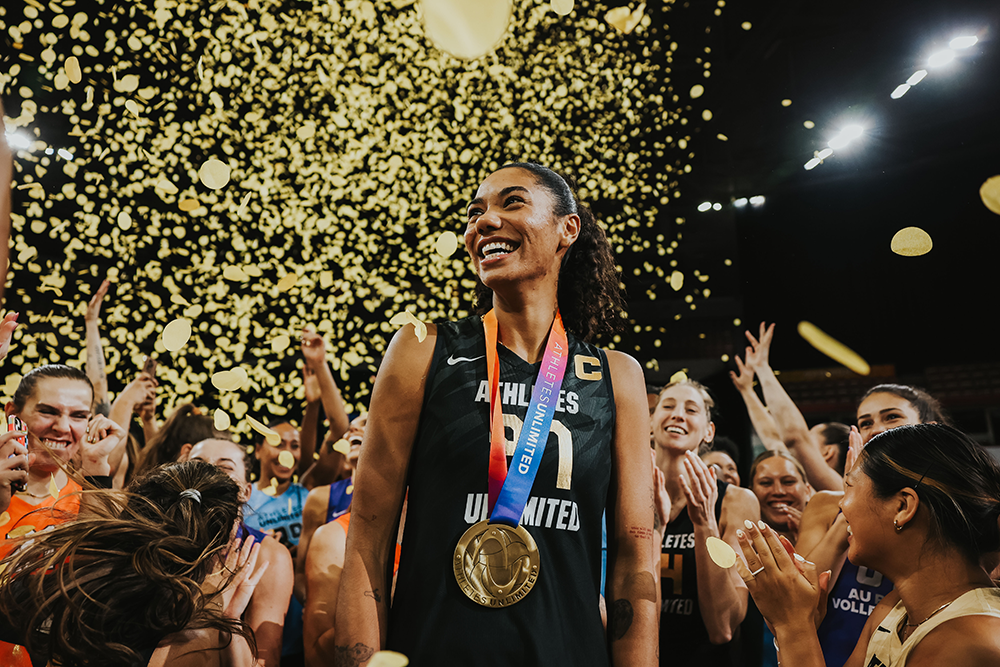
Jordan Thompson – Julia Kostopoulos (Volleyball)
Canon R1 | Canon 70-200 mm | F 2.8 / ISO 2000 / 1/1250 s
The Champion.
Jordan is truly the most kind, humble, hilarious, competitive, and incredibly talented human being, and I wanted to somehow capture all of that within one photo.
I had an idea in my head of what my confetti shot of Jordan would look like (or at least what I wanted it to look like). However, I had no control. I wasn’t sure exactly how the confetti would fall. I didn’t know what Jordan’s reaction would be, or what the other girls would do. All I could do was photograph what was in front of me.
Afterwards, I didn’t think I had gotten anything that I was going to be proud of. I even told Jade that I felt like I had nothing, but while going through the photos, I saw this photo. A photo of confetti flying everywhere, athletes cheering and dancing, and Jordan in the middle of the chaos with nothing but pure joy on her face. The pure, authentic, most genuine joy on her face is what makes this one of my most favorite photos from the 2025 season.

Molly McCage – Julia Kostopoulos (Volleyball)
Canon R1 | Canon 70-200 mm | F 2.8 / ISO 3200 / 1/1600
Molly McCage. Honestly, do I even need to say anything more?
This wasn’t my first time photographing Molly. I had taken photos of her during League One Volleyball’s inaugural season. After taking photos of her during the LOVB Championship, she was someone I was most excited to get to photograph again when I started working for Athletes Unlimited. I had witnessed firsthand the emotion she plays with and couldn’t wait for more of it.
As the AU season went on, Molly played each week with more intensity than the week prior, which made her celebrations that much more intense and incredibly fun to photograph. This photo is from the last weekend of play, hence it is one of the most intense celebration shots I captured of her this season.
Molly plays with so much heart, passion, and emotion, and she is truly so fun to photograph.

Morgan Hentz – Jade Hewitt (Volleyball)
Canon R1 | Sigma 35 mm Art | F 3.5 / ISO 500 / 1/1600 s
This image (and this whole photoshoot) will always hold a special place in my heart! With Volleyball being in both Omaha and Madison this year, I thought it would be fun to lean into the Midwest theme. During our time in Madison, we happened to be staying 15 minutes away from a pumpkin patch and corn maze (shoutout Schuster’s Farm!), and I thought, “Why not?”
So we packed our gear and drove to the cornfield, did some testers before the athletes arrived, and waited for the shoot to start. My energy was through the roof as we waited. The athletes rolled up in some absolutely fantastic outfits, we had a quick meeting, then went into the corn maze and got straight to work so so we didn’t miss the sunset. In this type of setting, I always like to meet with the group beforehand to go over the shooting schedule, plan of attack, address any safety issues, let them feel my energy, and answer any questions. I think it’s important for the athletes to know who is in control of the shoot and who will problem solve and keep the best interests of the group top of mind.
In addition to portraits, Julia and I wanted some movement through the corn where the athletes could run around and feel free in the space. If you know Morgan Hentz, you know she’s an actual ray of golden sunshine with the most infectious personality that is a joy to capture. I had Morgan moving away from me as we shot this photo, and I think the black and white edit just makes this photo feel like HAPPINESS. We edited and exported 1,198 images from this photoshoot, many of which came out unbelievably beautiful, but this one is my favorite.

Izzy Harrison – Jade Hewitt (Basketball)
Canon 1DX Mark III | Sigma 50 mm Art | F 3.5 / ISO 500 / 1/320 s
This photo kicked off 2025 in the best way! I wanted to start the year with a new Media Day setup that looked like nothing we had done before. The background, the lights, the set… all were new elements that invited the chance to capture something fresh.
Izzy Harrison truly needs nothing to make a stunning photo, but with all the new elements, she absolutely delivered a banger of an image. I love the texture in her hair and how the warmth of the background accentuates her glowing skin. Izzy has such a powerful look and intense focus in her eyes… she has an aura about her. I remember taking this photo and looking at Izzy and saying, “ARE YOU KIDDING ME!?” I exported this photo so fast and sent it to the social team to get on social media ASAP to hype up Media Day!
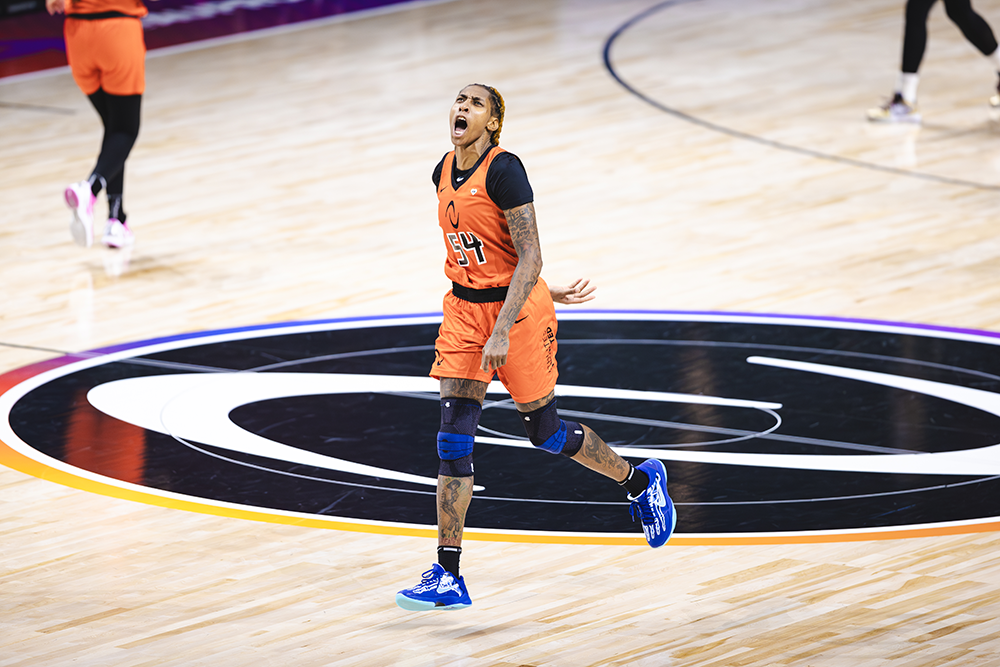
Crystal Bradford – Jade Hewitt (Basketball)
Canon 1DX Mark III | Canon 300 mm | F 2.8 / ISO 3200 / 1/1000 s
I can’t think of another player at Athletes Unlimited who is anything like Crystal Bradford. She has such a unique, bold, and genuine personality that makes her so much FUN to photograph. She had such a fantastic 2025 AU season, so I found myself keeping the camera on her as often as I could.
This image was shot from the stands with a 300 mm lens. Such a long lens can be great for close-ups, but tricky when athletes get in a mid-court range where they’re too far for a close-up, but too close for full body. I caught Crystal right in the sweet spot with the logo perfectly placed behind her and an on-brand celebration for a huge 3-pointer. You could sit on Crystal for five minutes of any game and shoot a banger, but this one felt special. Crystal played such an impressive season and gave the whole Content Team the emotional shots we live for!

The Court from Above – Meghan Murphy (Basketball)
Nikon Z6 II | Nikon 24-70 mm | F 2.8 / ISO 50 / 1/30 s
Before tipoff on Gameday 6 of the 2025 season, my assignment began in the shadows above the arena lights. With a 24–70 mm lens and a tether clipped tight to my harness, I hiked through backstage corridors, passing posters of the legends—singers, hoopers, trailblazers—who helped build the mythology of the Nashville Municipal Auditorium. The climb ended with a nearly 90-degree staircase, each step secured by moving my carabiner to the next post while the court grew smaller beneath me. It was the first time in my career I’d ever been granted access to a vantage point this high, and I had only a couple of minutes to circle the rafters as the clock ticked down—no flash, just me, one camera, one lens; searching for the angle I’d imagined.
Inspired by the legendary NBA photos of players suspended mid-air—layups, dunks, the ball caught in that impossible stillness—I wanted to capture this women’s game from that same timeless vantage point. At a shutter of 1/30s, I waited for the breath-length moment when the ball left a player’s hands and hung halfway to the net, 43 seconds on the clock, and no one knowing the outcome until gravity decides. From the rafters, that fraction of a second felt monumental—another defining frame in the evolving story of women’s sports.

Suriya (Sam) McGuire – Jade Hewitt (Basketball)
Canon 1DX Mark III | Sigma 35 mm Art | F 2.8 / ISO 2000 / 1/125 s
This photo is the “random” photo of the year! The athletes had a group outing to a custom hat-making session in Nashville, and I went along to capture the experience. We went pretty close to sunset, so there wasn’t a lot of light left outside to take any photos of the athlete’s finished creations, but I was able to sneak out with Sam and shoot her new hat.
Little did I know that this photo would pop off on social media! I’m not sure anyone has a better facecard than Sam, and people on social media went crazy. Her brown hat, the brown jacket, and the brick wall made this photo an absolute Nashville vibe. We don’t expect to take bangers on mid-week athlete outings, but Sam came through with her look into the camera and cowboy hat!
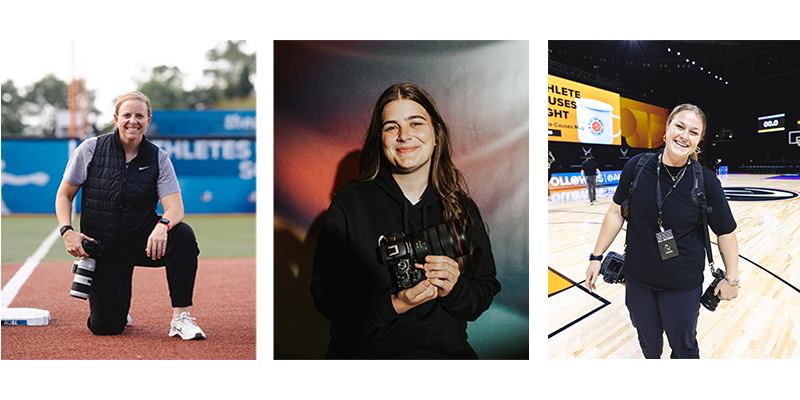
Left: Jade Hewitt is the Director of Photography at Athetes Unlimited.
Middle: Julia Kostopoulos is a photographer at Athletes Unlimited.
Right: Meghan Murphy is a freelance photographer for Athletes Unlimited.
-

 Motorsports2 weeks ago
Motorsports2 weeks agoSoundGear Named Entitlement Sponsor of Spears CARS Tour Southwest Opener
-

 Rec Sports3 weeks ago
Rec Sports3 weeks agoBlack Bear Revises Recording Policies After Rulebook Language Surfaces via Lever
-

 Motorsports2 weeks ago
Motorsports2 weeks agoDonny Schatz finds new home for 2026, inks full-time deal with CJB Motorsports – InForum
-

 Rec Sports2 weeks ago
Rec Sports2 weeks agoHow Donald Trump became FIFA’s ‘soccer president’ long before World Cup draw
-

 Rec Sports2 weeks ago
Rec Sports2 weeks agoDavid Blitzer, Harris Blitzer Sports & Entertainment
-

 Motorsports2 weeks ago
Motorsports2 weeks agoJR Motorsports Confirms Death Of NASCAR Veteran Michael Annett At Age 39
-
Sports2 weeks ago
Elliot and Thuotte Highlight Men’s Indoor Track and Field Season Opener
-

 Motorsports2 weeks ago
Motorsports2 weeks agoRick Ware Racing switching to Chevrolet for 2026
-
Sports2 weeks ago
West Fargo volleyball coach Kelsey Titus resigns after four seasons – InForum
-

 Sports1 week ago
Sports1 week ago#11 Volleyball Practices, Then Meets Media Prior to #2 Kentucky Match


